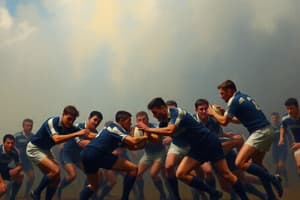Podcast
Questions and Answers
A player serving a penalty can be substituted.
A player serving a penalty can be substituted.
False (B)
Substitutes can enter the court directly from the bench.
Substitutes can enter the court directly from the bench.
False (B)
A held ball occurs when only one player has possession of the ball.
A held ball occurs when only one player has possession of the ball.
False (B)
A referee can deny a substitution if the players are not ready to enter the court and play.
A referee can deny a substitution if the players are not ready to enter the court and play.
The Timekeeper signals the Referees when a substitution is requested.
The Timekeeper signals the Referees when a substitution is requested.
Substitutions can be made after a try has been scored without any additional stoppage in play.
Substitutions can be made after a try has been scored without any additional stoppage in play.
A held ball results in the game being stopped and a throw-in being awarded to the team with the next possession.
A held ball results in the game being stopped and a throw-in being awarded to the team with the next possession.
Substitutes must inform the Referee of the substitution.
Substitutes must inform the Referee of the substitution.
A referee can only allow substitutions after a try has been scored.
A referee can only allow substitutions after a try has been scored.
A held ball occurs when a live ball becomes stuck under a single player's wheelchair.
A held ball occurs when a live ball becomes stuck under a single player's wheelchair.
Flashcards are hidden until you start studying
Study Notes
Substitutions
- Substitutions can be made after a stoppage in play, except immediately after a try has been scored.
- Substitutes must inform the score table of the substitution and report to the substitution area prior to the stoppage in play.
- The Timekeeper signals the Referees that a substitution has been requested at the next stoppage in play.
- The Referee determines if a substitution is permitted and acknowledges the request, allowing substitutes to enter the court.
- Substitutes must be ready to enter the court and play immediately, or the Referee may deny permission.
Held Ball
- A held ball occurs when two or more opposing players have possession of the ball simultaneously.
- A held ball also occurs when two or more opposing players cause the ball to go out-of-bounds at the same time.
- If a live ball becomes stuck between two or more opposing players' wheelchairs, or trapped under a wheelchair, it is considered a held ball.
- When a held ball occurs, the Referee blows their whistle, signals a held ball, and stops play.
- The team that has the next possession under the alternating possession process (Article 62) gets the ball for a throw-in.
- A player cannot intentionally cause a held ball by placing the ball at the disposal of an opponent or trapping the ball under their wheelchair.
Studying That Suits You
Use AI to generate personalized quizzes and flashcards to suit your learning preferences.



